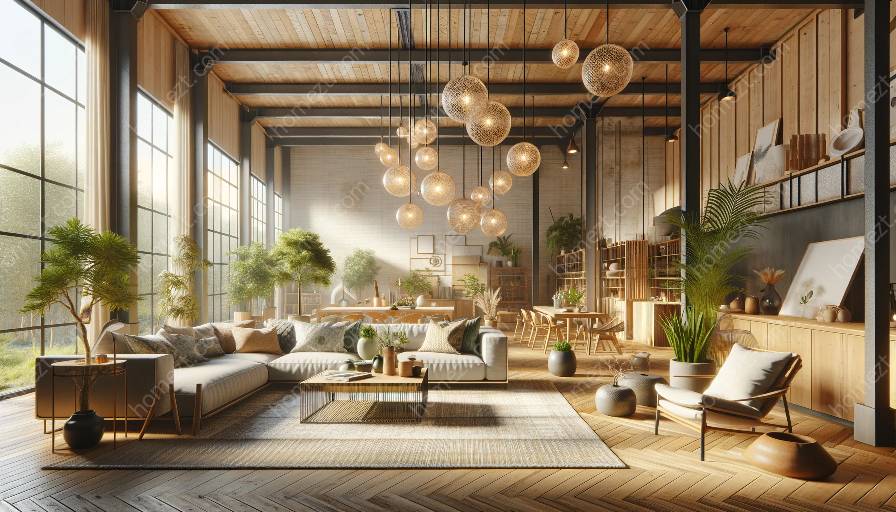Interior design is constantly evolving, as designers and homeowners alike seek to create spaces that are not only beautiful but also environmentally friendly. One of the key ways to achieve this is by incorporating eco-friendly materials into interior design. In this article, we will explore how sustainable and eco-friendly design principles can be applied to interior design and styling, and how the latest trends in eco-conscious materials are shaping the way we approach interior design.
Sustainable and Eco-Friendly Design
Sustainable and eco-friendly design is a design philosophy that aims to minimize the environmental impact of a space's construction and operation. This approach encompasses a range of principles, including energy efficiency, the use of recycled and renewable materials, and the reduction of waste and pollution. When applied to interior design, these principles can result in spaces that are not only visually appealing but also promote a healthier and more sustainable way of living.
Principles of Sustainable and Eco-Friendly Design
There are several key principles that guide sustainable and eco-friendly design in interior spaces:
- Use of Recycled and Renewable Materials: One of the hallmarks of sustainable design is the use of materials that have been recycled or can be easily renewed. This helps reduce the demand for new resources and minimizes the environmental impact of sourcing materials.
- Energy Efficiency: Designing spaces that are energy-efficient can significantly reduce a building's carbon footprint. This can include using energy-efficient appliances and lighting, as well as maximizing natural light and ventilation to reduce the need for artificial heating and cooling.
- Waste Reduction and Recycling: Designers can also minimize waste by carefully planning and managing construction processes, as well as incorporating recycling systems for materials that are no longer needed.
- Indoor Air Quality: Sustainable design also considers the health and well-being of occupants by using materials that contribute to better indoor air quality, such as low-VOC paints and finishes, and natural, non-toxic materials.
Incorporating Eco-Friendly Materials
With the increasing availability of eco-friendly materials, designers and homeowners have a wide range of options to choose from when it comes to incorporating sustainability into interior design:
1. Reclaimed Wood and Salvaged Materials
Reclaimed wood and salvaged materials not only add character to a space but also reduce the demand for new resources. From flooring to furniture, using reclaimed wood can bring a sense of history and sustainability to a design.
2. Sustainable Flooring Materials
Options such as bamboo, cork, and recycled metal tiles offer sustainable alternatives to traditional flooring materials like hardwood or carpet. These materials are not only environmentally friendly but also durable and stylish.
3. Eco-Friendly Paints and Finishes
Low-VOC paints and finishes are becoming increasingly popular in interior design for their minimal impact on indoor air quality. Additionally, natural finishes such as clay plasters and lime wash provide eco-friendly alternatives to conventional paint.
4. Renewable and Recycled Furniture
Furniture made from renewable resources or recycled materials provides a sustainable and stylish option for interior design. From bamboo chairs to recycled plastic tables, there are countless options available to furnish a space sustainably.
5. Energy-Efficient Lighting
LED lighting and other energy-efficient fixtures not only reduce a space's energy consumption but also offer versatile and stylish lighting options for interior design.
Trends in Eco-Friendly Interior Design
The world of interior design is constantly evolving, and the growing demand for eco-friendly living has given rise to several notable trends:
1. Biophilic Design
Biophilic design seeks to connect people with the natural environment by incorporating elements of nature into interior spaces. This trend includes the use of natural materials, abundant natural light, and the incorporation of plant life into interior design.
2. Modular and Sustainable Furnishings
Modular furniture designed for sustainability and adaptability has become increasingly popular in interior design. These pieces can be reconfigured and repurposed to meet changing needs, minimizing waste and resource consumption.
3. Smart and Energy-Efficient Technology
The integration of smart, energy-efficient technology into interior design has revolutionized the way we interact with our living spaces. From automated lighting systems to smart thermostats, these advancements contribute to a more sustainable and efficient home environment.
Conclusion
Integrating eco-friendly materials into interior design is not only a trend but a responsible and forward-thinking approach to creating living spaces that are both aesthetically pleasing and environmentally sustainable. By embracing the principles of sustainable and eco-friendly design, and utilizing the latest trends in eco-conscious materials, interior designers and homeowners can play a vital role in promoting a greener and healthier future.


























